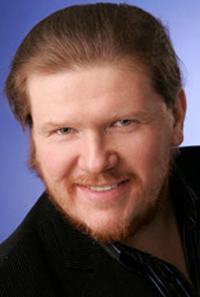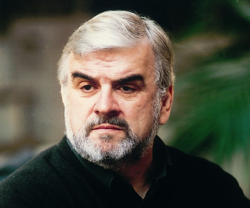Instead, it would be the Canadian debut of ensemble studio
soprano, Yannick-Muriel Noah. Many performers have gotten their ìbig
breakî by filling in for a sick colleague and in these situations; the
somewhat indecisive role of the ìunderstudyî suddenly becomes something
magical. By having the opportunity to show their musical goods, huge
international careers have been launched as a result of this very situation.
And so, once the announcement was made, Pucciniís Tosca took on
quite a different air: one of a fictional tale of real and passionate
emotions juxtaposed with the non-fictional reality of a young opera singer
making her debut as a fictional opera singer, Floria Tosca.
Pucciniís Tosca is often presented in one of two ways: it can
be exciting and exhilarating, leaving one touched at one womanís
unwavering determination, or it can fall flat on its face should its
diminutive cast be at all weak in their characterization. This production was
a little of both. The one overall aspect that lacked focus was the common
Puccinian dichotomy of Eros and Thanatos (Love and Death) which lies
at the heart of this work. Cleverly, Puccini imbues the orchestral fabric
with wonderfully suggestive moments that indicate this dichotomy, but if
Tosca is to be successful, the characters must also inhabit each of
these elements at a given point within the opera.
In Tosca, Puccini sews with the thread of religion, a topic that
he was not so interested in, except for in his later Suor Angelica.
In essence, the religious component in Angelica has nothing to do
with religion at all, more than it uses the overall ideal of a religious
setting to approach a story about a girl who got herself pregnant out of
wedlock. It is a story of sin and redemption in the sense of a woman atoning
for sexual urges. Atoning for love, passion, and sex by suffering and death
is the concoction that Puccini continually fills into his syringe. With it,
he pierces us and tries to teach us the more difficult lessons of living and
loving. Tosca functions in an identical manner, however, this
production failed to express these elements, for the most part. There were,
however, several moments of excellent music making.
 Conductor, Richard Buckley
Conductor, Richard Buckley
The first act began with an elegant sound in the orchestra and a
well-chosen tempo by conductor Richard Buckley. He maintained a balanced
orchestra fabric, if perhaps it was sometimes lacking in the larger and more
dramatic moments where the orchestra is telling of the characterís
innermost emotions. The Sacristan, played by Robert Pomakov, was directed in
a rather incoherent way, for Puccinian aesthetics. The music of the Sacristan
is light-hearted but his religious aura and pious nature are not to be
affected. His piety was obscured by Pomakovís almost spastic, buffo-like
actions. Nowhere does Puccini indicate that the sacristan is a comical
character. There is an indication in the score that the Sacristan has a
ìticî in his neck, but this element of character was dramatically
overdone and became somewhat ridiculous. Although Pomokovís voice is quite
lovely, the Italian was unacceptable for a house of this magnitude. There
were aspirations of all sorts, where the authentic Italian language does not
consist of these aspirations in consonants but is softer and rounder.
Doubled-consonants are stopped with the tongue to create the proper affect
and unfortunately Pomakovís Italian was much too Americanized to pass for
authenticity.
The set was quite lovely and spacious: on the left, the portrait of the
Contessa Attavanti, and on the right an altar to the Madonna. The orchestral
tempi were well chosen and the orchestraís beautiful playing certainly
overshadowed the inconsistent dramatic purpose of the Sacristan in the
opening. Cavaradossiís entrance was cavalier as tenor Mikhail Agafanov
filled the stage with a handsome and testosterone-filled presence. The
orchestral horns were brilliant at this moment and set the stage for the pure
tenore affogato sound that is expected of Puccinian singing.
 Tenor, Mikhail Agavonov
Tenor, Mikhail Agavonov
Although Agafonov has a tremendous upper tessitura, his singing was often
not as legato as Puccinian aesthetics require. In his letters and the
journals of singers with whom he coached, Puccini indicated that the legato
line was to be carried ìnot from note to note, as in Mozart, but carried
through every note in between the notes he had written on the page.î
Simply, that means that his music requires an influx of portamenti,
graceful sliding from note to note, which were not successfully applied to
this production in its entirety. It was sung in a very strict manner,
unfortunately, where the application of legato sul fiato (singing on
the breath) means a very different thing for Puccini.
The woodwinds were precise in their entry to Cavaradossiís first aria,
ìRecondita Armonia,î which was rather disappointing. For some reason, Mr.
Agavonov seemed to sing more effectively during passages of
Cantilena or Arioso rather than in a full-blown aria. This
aria is where the first flickering of Cavaradossiís passion begins to
spark, its ultimate purpose being to cause the audience to fall in love with
him, so that we may further relate to Tosca. Unfortunately, Agavonovís
expression failed to ignite the audience. The arias in Puccini should be sung
with a completely spinning line and very little straightening of that sound,
as in pure Bel Canto singing, however, this was not the case for
Agavonov. It is a lovely sound but tends to lose in the middle and lower
tessitura because of his straightened tones. These, on several occasions,
even caused him to sing under the pitch. The orchestra, however, was
excellent.
The acting was mediocre at best, where Pucciniís works are meant to
represent ìrealismî in its most definitive operatic ideal. The acting
should always be larger-than-life, but here it lacked in energy and
spontaneity. Toscaís anticipated entrance was a glimmer of hope to save
things and Ms. Noah entered with an air of authority, although her first
vocal entry showed a great deal of nervousness. It is a large and powerful
voice with a blood-red colour and golden hues in the upper tessitura. Ms.
Noahís nerves got the best of her in the first act, which was not
surprising. The orchestra began to emerge more readily, as Puccini demands at
Toscaís entry and was aesthetically excellent. Praises go to Maestro
Buckley for his control and precise handling of the delicate music.
 Soprano, Yannick-Muriel Noah
Soprano, Yannick-Muriel Noah
Ms. Noahís acting also was sporadic and the necessary spark that was
supposed to ignite a passion worth dying for, between Tosca and Cavarodossi,
would never occur. Unfortunately, Ms. Noahís nerves and the lack of
intimacy between the two singers caused the first act to be inconsistent and
quite boring. The tremendous quality of Ms. Noahís voice is unquestionable,
but she is perhaps too young yet to sing a Tosca. She had some difficulty in
the upper tessitura in the first act and parts of the second, where Tosca is
a role that requires a grand maturity a completely solid upper tessitura. She
deserves respect, however, for having the guts to perform it in a house of
this magnitude and give it her best.
Once she got going, Ms. Noahís voice exhibited beautiful timbres and she
showed us that she possesses a tremendous upper voice, which she eloquently
displayed in the second Act where she was much more comfortable and settled.
Unfortunately, she did not define Toscaís jealousy sufficiently, especially
in singing of the important words of Toscaís jealousy ìQuei occhi.î
There was simply not enough emphasis on this text and really, it was almost
inaudible. The interchange between Tosca and Cavaradossi was not very
interesting and Agavonov was flat in several instances here. He sang
excellently, however, the words ìFloria, TíAmoîÖif he had sung
everything as he did this line, the entire mood of the presentation might
have been different. In addition, had there been a good stage kiss, perhaps a
more erotic mood might have prevailed; one that is necessary for any
Puccinian opera, where human passions are at their most extreme. Because this
opera has a very small cast, the necessity of that kiss is imperative to the
personal relationship between Tosca and Mario. There was not even a touching
of lips.
Andrew Stewart, who played the prisoner, Angelotti, had good stage
presence but his diction was completely inaudible and unfortunately continued
to show a lack of consistency in this production. The chorus, however, was
the brimming light of this production and praises go to Sandra Horst for her
direction and attention to detail. The chorus had the most authentic Italian
sound in this production, and were wonderfully unified whole. Bravi!!!
 Baritone, Alan Opie
Baritone, Alan Opie
At the end of Act 1, Alan Opieís entrance, as Scarpia, was a little thin
in the orchestral texture. Maestro Buckley could have let it rip a little
more, especially with those luscious and most descriptive harmonic chords.
Mr. Opieís Italian was better than his colleaguesí and this along with
his more consummate acting abilities were enough to change the direction of
the production up to this point. His baritone was quite lovely, if a bit thin
for a Scarpia, and a little weak in the upper tessitura.
The Te Deum, of course, was the highlight of the first act with a
full processional in complete religious attire. The children of the chorus
were delightful. The addition of the organ and tubular bells gave a majestic
aura of supreme grandiosity. It was fantastically done. The drama was created
simply by the direction of the chorus, with three prostrate priests lying
down as if attaining their ordination and the grandeur and majesty of the
procession. The Te Deum is the catalyst that moves the more
religious first act into the sinful, painful torture of Cavaradossi , and the
attempted rape of Tosca. Act 1 is Eros.
Act 2 is Thanatos (Death). It began with strong dramatic intensity, with
Scarpia lovingly caressing the letter opener that would soon be the cause of
his death. Again, the orchestra looms the dichotomy of love and death . If
the first act is love, then the second act is death and Pucciniís sadistic
penchant becomes the focus of the act. The low Brass in the orchestra shone
forth in this instance with some exquisite playing while intoning a
foretelling funeralistic dirge.
Ms. Noahís performance of Toscaís ìCantata,î (sung offstage) was
quite lovely and it was obvious that she was going to be ìdifferentî in
this act. La Scena degli strazzi (the torture scene) with
Cavaradossi being battered for information was rather fake in its drama. The
scene has to be more realistic for it to work and this was an example where
it unfortunately failed. The opening of the secret vault leading to a more
effective torture chamber was quite brilliant and the addition of Pucciniís
dissonances began the crescendo of drama that would end in Scarpiaís
murder.
Finally, Ms. Noah seemed to engulf herself in Toscaís character and her
upper tessitura opened significantly. The power of this voice is quite
tremendous; however, the drama required her to be more defiant in her
character. She seemed more sporadic and pacing than defiant. She could have
been more hateful in throwing piercing words at Scarpia, like
ìAssassino!î The decisive moment at the text ìIl Prezzo,î where Tosca
asks the cost of Marioís freedom required more space. Tosca already knows
the cost but for this scene to work, as Puccini dramatically set it, the
momentum between the torture scene and the instance of this question has to
be maintained.
When Scarpia finally attacks Tosca, the acting was powerful with Mr.
Opie throwing her down on the coach while pressing himself on top of her.
That he exposed a good deal of flesh by lifting her dress was appropriate
here. There are no holds barred with Puccini and he would have rightfully
approved of this type of stage direction. Had the entire opera possessed this
kind of realistic drama and erotic intensity, the production as a whole would
have been more successful.
Tosca crawls along the floor to escape Scarpiaís clutches and ends at a
chair on her knees to sing her famous ìVissi DíArte.î Ms. Noah sang it
rather strictly and without the necessary Puccinian punto di linea that the
composer indicated to sopranos like Maria Jeritza. Several moments within the
aria required more attention to diction, such as the missing
doubled-consonants. It was a little rushed, but it was apparent that Ms. Noah
took it at a safe and moving tempo. In effect, Ms. Noah exhibited her voice
more potently here and she really gave it to her audience as much as
possible. The audience broke out in a roar of support and encouragement for
her, as if to say, ìKeep singing and we will support you.î
Scarpiaís murder was quite realistic and Ms. Noah chose to use an
affective chest-voice to utter the affectionate words ìmuori dannato,î
(die in damnation)! Even moreso, she spoke the words ìDíavanti ‡ lui
tremava tutta Romaî (In front of him all of Rome trembled) with great
hatred; although, to be even more affective she might have taken more time
here and really rolled out the ìrî in the word ìtremavaî as if to add
some reality to the word, tremble.
The set for Act III was interesting, with the top of the Castel
SantíAngelo exposed as a large cistern in which Tosca would plummet to her
eventual death. The mood created by the set, lighting, and orchestra was
quite powerful, but when Agafonov sang ìE lucevan le Stelle,î the mood
was broken. This aria was the poorest of the evening with several
inconsistencies between the orchestra and Agavonov. In an aria that usually
stops the show, there wasnít one morsel of applause and the show continued
on toward the end. Mr. Agavonovís upper range is quite impressive but his
middle was lacking intensity in the aria. His burnished colour was
appropriate but he lacked the necessary slancio that this particular
aria requires. The orchestra, however, was supportive and the woodwinds gave
the essence of a spectacular heart-wrenching moment, but Mr. Agavonov did not
take on their motive well.
The finale brought a powerful dramatic climax with the firing of the
gun-squad and the ësupposedí fake-death of Mario. Ms. Noahís reaction
to his death was vocally secure, but dramatically thin. Her despair needed to
follow her up those steps to the roof of the Castel SantíAngelo and in
final vengeance utter her final words, ìO Scarpia, avanti a Dio!î (In
front of God, Scarpia!).
Although the production was not outstanding, the house itself is
acoustically wonderful and the orchestra was superb in their delivery,
interest in the drama, and depth of colour. Tosca is a difficult
opera, in that it rests securely on the merits of the two lead roles.
Whatever weakness the singers possess, will result in the charactersí
weakness. A good attempt by two very fine voices but, as a whole, the lack of
distinct Puccinian aesthetics applied to this performance and the need for a
just more raw and erotic relationship between Mario and Tosca caused it to be
less than spectacular.
Mary-Lou P. Vetere
PhD (ABD), M.A., Mus.B
image=http://www.operatoday.com/Four-Seasons-Centre-for-the.png
image_description=Four Seasons Centre, Toronto, Ontario
product=yes
product_title=Giacomo Puccini: Tosca
product_by=Canadian Opera Company, Four Seasons Centre for the Performing Arts
product_id=Cesare Angelotti: Andrew Stewart
Sacristan: Robert Pomakov
Mario Cavaradossi: Mikhail Agafonov
Floria Tosca: Yannick-Muriel Noah (debut performance)
Baron Scarpia: Alan Opie
Spoletta: John Kriter
Sciarrone: Jon-Paul DÈcosse
A Jailer: Andrew Stewart
Shepherd Boy: Dov Houle
Conductor: Richard Buckley
Directed by Paul Curran
Chorus Master: Sandra Horst